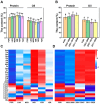Comprehensive Evaluation of Nutritional Quality Diversity in Cottonseeds from 259 Upland Cotton Germplasms
- PMID: 40870807
- PMCID: PMC12385719
- DOI: 10.3390/foods14162895
Comprehensive Evaluation of Nutritional Quality Diversity in Cottonseeds from 259 Upland Cotton Germplasms
Abstract
Cottonseeds, rich in high-quality protein and fatty acids, represent a vital plant-derived feedstuff and edible oil resource. To systematically investigate genetic variation patterns in nutritional quality and screen superior germplasm, this study analyzed 26 nutritional quality traits and 8 fiber traits across 259 upland cotton (Gossypium hirsutum L.) accessions using multivariate statistical approaches. Results revealed significant genetic diversity in cottonseed nutritional profiles, with coefficients of variation ranging from 3.42% to 26.37%. Moreover, with advancements in breeding periods, the contents of protein, amino acids, and the proportion of unsaturated fatty acids (UFAs) increased, while oil content and C16:0 levels decreased. Correlation analyses identified significant positive associations (p < 0.05) between proteins, amino acids, UFAs, and most fiber traits, except for seed index (SI), fiber micronaire (FM), and fiber elongation (FE). Through a principal component analysis-fuzzy membership function (PCA-FMF) model, 13 elite accessions (F > 0.75) with high protein content, high UFA proportion, and excellent fiber quality were identified. These findings provide both data-driven foundations and practical germplasm resources for value-added utilization of cottonseed and coordinated breeding for dual-quality traits of nutrition and fiber.
Keywords: Gossypium hirsutum L.; comprehensive evaluation; cottonseed; fiber quality; nutritional quality.
Conflict of interest statement
The authors declare no conflicts of interest.
Figures




Similar articles
-
Genetic diversity and comprehensive evaluation of physicochemical traits in Phyllanthus emblica L. for breeding and resource utilization.BMC Plant Biol. 2025 Sep 2;25(1):1187. doi: 10.1186/s12870-025-07161-x. BMC Plant Biol. 2025. PMID: 40898031
-
GWAS and GS analysis revealed the selection and prediction efficiency for yield, plant morphological, and fiber quality in Gossypium barbadense.Theor Appl Genet. 2025 Jun 9;138(7):138. doi: 10.1007/s00122-025-04911-1. Theor Appl Genet. 2025. PMID: 40484873
-
Lint percentage and boll weight QTLs in three excellent upland cotton (Gossypium hirsutum): ZR014121, CCRI60, and EZ60.BMC Plant Biol. 2023 Apr 5;23(1):179. doi: 10.1186/s12870-023-04147-5. BMC Plant Biol. 2023. PMID: 37020180 Free PMC article.
-
The National Plant Germplasm System cotton collection-a review of germplasm resources, phenotypic characterization, and genomic variation.Theor Appl Genet. 2025 Aug 20;138(9):220. doi: 10.1007/s00122-025-05009-4. Theor Appl Genet. 2025. PMID: 40833628 Review.
-
The Efficacy of Nutritional Interventions in Reducing Childhood/Youth Aggressive and Antisocial Behavior: A Mixed-Methods Systematic Review and Meta-Analysis.Campbell Syst Rev. 2025 Aug 10;21(3):e70059. doi: 10.1002/cl2.70059. eCollection 2025 Sep. Campbell Syst Rev. 2025. PMID: 40786968 Free PMC article. Review.
References
-
- Cai Y., Xie Y., Liu J. Glandless seed and glanded plant research in cotton. A review. Agron. Sustain. Dev. 2010;30:181–190. doi: 10.1051/agro/2008024. - DOI
Grants and funding
LinkOut - more resources
Full Text Sources

